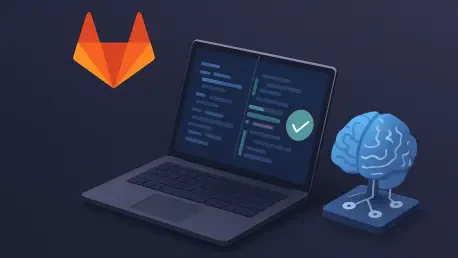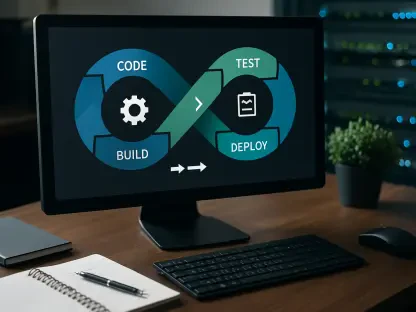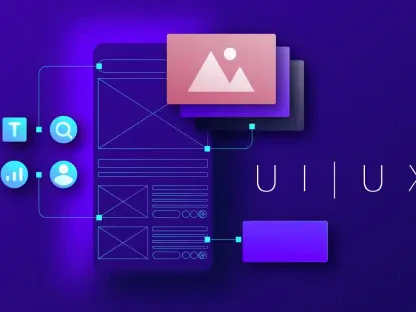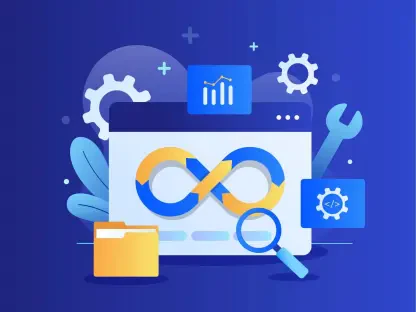In the fast-paced world of software development, where collaboration often leads to tangled code conflicts and delayed deployments, a groundbreaking solution has emerged to ease the burden on developers. GitLab’s AI Merge Agent, launched on November 14, is reshaping the landscape of DevSecOps by automating one of the most tedious aspects of coding: merge conflict resolution and pull request (PR) validation. This tool isn’t just a minor upgrade—it’s a seismic shift that promises to save time, boost productivity, and let teams focus on innovation rather than troubleshooting. With an 85% success rate in resolving merges and a 30% reduction in CI/CD (Continuous Integration/Continuous Deployment) times for early adopters, as highlighted in GitLab’s official announcements, this technology addresses pain points that have long plagued enterprise teams. It’s a glimpse into a future where repetitive tasks are handled by intelligent systems, raising curiosity about how far automation can truly take software development workflows.
The Power of Automation in Code Merges
Revolutionizing Workflow Efficiency
The core strength of GitLab’s AI Merge Agent lies in its ability to streamline workflows through advanced automation, fundamentally changing how developers approach code merges. Integrated seamlessly into GitLab’s DevSecOps platform, this tool employs machine learning to analyze code changes, detect potential conflicts, and resolve them without human intervention in most cases. Early reports indicate that enterprise teams, often managing hundreds of conflicts weekly, have experienced dramatic improvements in efficiency. The agent not only identifies discrepancies between code branches but also simulates merge outcomes to ensure stability before integration. This level of automation means developers spend less time on manual fixes and more on crafting solutions to complex problems, a shift that could redefine productivity standards across the industry. As a result, the frustration of delayed CI/CD pipelines is becoming a relic of the past for many teams adopting this technology.
Beyond just resolving conflicts, the AI Merge Agent enhances team dynamics by freeing up mental bandwidth for creative tasks. Feedback from enterprise users, shared through various developer communities, paints a vivid picture of transformation. A lead developer from a Fortune 500 company noted that what used to be hours of painstaking conflict resolution now takes mere minutes, allowing their team to pivot to brainstorming new features instead. This isn’t merely about saving time—it’s about redirecting focus toward innovation and high-value work. The reported 30% reduction in CI/CD cycle times further underscores this impact, as faster merges translate directly to quicker iterations and deployments. For organizations operating in competitive markets, this speed advantage can mean the difference between leading the pack and falling behind. The ripple effect of such efficiency gains is evident in how teams collaborate, with reduced friction paving the way for smoother, more cohesive projects.
Elevating Code Quality Through Automation
Another profound benefit of the AI Merge Agent is its contribution to maintaining high code quality, a critical concern in collaborative environments. By automating pull request testing alongside conflict resolution, the tool ensures that merged code meets predefined standards before it reaches production. This minimizes the risk of introducing bugs or breaking existing functionality, a common hazard in manual merge processes. The agent’s ability to run automated tests within CI/CD pipelines acts as a safety net, catching issues that might otherwise slip through. Enterprise teams have reported fewer rollback incidents since adopting the tool, highlighting its role as a guardian of reliability. This focus on quality assurance through automation is especially vital for large-scale projects where even minor errors can cascade into significant setbacks, costing time and resources.
Moreover, the consistency brought by the AI Merge Agent fosters trust in the development process among stakeholders. Unlike human-driven merges, which can vary in thoroughness depending on experience or workload, the agent applies a uniform approach to every task. It adheres to established protocols without deviation, ensuring that no merge bypasses critical checks. This reliability is a game-changer for teams under pressure to deliver flawless software at rapid speeds. Additionally, the reduction in human error means that developers can confidently integrate changes, knowing the system has their back. For industries where precision is non-negotiable, such as finance or healthcare, this level of dependability could set a new benchmark. As adoption grows, the agent’s impact on maintaining high standards may well become a cornerstone of modern software development practices.
Security and Compliance in AI-Driven Merges
Balancing Speed with Safety
While the AI Merge Agent excels in accelerating code merges, it doesn’t compromise on the critical aspects of security and compliance, a priority for enterprise environments. Designed to integrate with secure CI/CD containers, the tool ensures that automated processes align with organizational standards and branch protection rules. This is no small feat, as industries with stringent regulations—such as banking or government sectors—cannot afford lapses in protocol, even for the sake of efficiency. GitLab’s emphasis on embedding security features into the agent addresses these concerns head-on, allowing teams to adopt automation without risking vulnerabilities. Reports from industry analyses emphasize that this balance is a key reason why large organizations are embracing the technology, as it mitigates the fear of automation introducing unseen flaws into critical systems.
Equally important is the agent’s role in maintaining audit trails and accountability during the merge process. Every action taken by the AI is logged and traceable, ensuring transparency for compliance reviews or post-incident investigations. This capability reassures enterprises that adopting cutting-edge tools won’t lead to regulatory headaches down the line. Furthermore, the agent’s adherence to predefined security policies means that merges are not just fast but also safe, protecting sensitive codebases from unauthorized or risky changes. For teams operating under tight governance frameworks, this feature is a lifeline, enabling innovation without sacrificing oversight. As cyber threats continue to evolve, having a tool that prioritizes secure workflows alongside speed positions GitLab as a trusted partner for organizations navigating the complex intersection of technology and regulation.
Ensuring Trust in Automated Systems
Building trust in AI-driven tools like the Merge Agent is paramount, especially when security is at stake, and GitLab has taken steps to address this concern. The tool’s design allows for customizable configurations, letting organizations tailor its behavior to match specific security protocols or risk tolerances. This flexibility ensures that automation doesn’t feel like a black box—teams can set boundaries on what the AI handles independently versus what requires human approval. Industry feedback suggests that this adaptability is crucial for gaining buy-in from skeptical stakeholders who worry about ceding control to algorithms. By providing visibility into the agent’s decision-making process, GitLab fosters confidence that automated merges won’t bypass critical safeguards or expose systems to unnecessary risks.
Additionally, the AI Merge Agent undergoes continuous updates to address emerging security challenges, ensuring it remains a reliable component of enterprise workflows. These updates are informed by real-world usage data, allowing the tool to adapt to new threats or compliance requirements over time. This proactive approach contrasts with static tools that may become obsolete as standards shift. For organizations, this means the agent isn’t just a short-term fix but a long-term ally in maintaining secure development practices. The emphasis on iterative improvement also signals a commitment to staying ahead of potential vulnerabilities, a factor that resonates with teams tasked with protecting high-stakes applications. As trust in such systems grows, the agent could pave the way for broader acceptance of AI in sensitive areas of software development.
Industry Trends and Competitive Landscape
Setting a New Benchmark
The arrival of GitLab’s AI Merge Agent signals a broader industry shift toward AI-driven autonomy in DevOps, positioning it as a benchmark for innovation. Building on earlier advancements in GitLab’s platform, such as features introduced in versions 18.3 and 18.5, this tool reflects a natural progression toward smarter workflows. Industry analyses point to a growing consensus that automation is no longer optional but essential for tackling bottlenecks in high-velocity development environments. The agent’s ability to handle complex tasks with minimal oversight aligns with the increasing demand for efficiency in software delivery. As competitors race to integrate similar capabilities, GitLab’s comprehensive approach—combining automation, security, and enterprise scalability—sets it apart as a leader in redefining how teams manage code integration.
This trend isn’t happening in isolation; it’s part of a competitive landscape where AI is becoming a key differentiator among DevOps tools. Other players in the market are launching comparable solutions focused on conflict prevention and team visibility, intensifying the push for innovation. However, GitLab’s offering stands out due to its deep integration with existing CI/CD pipelines and its focus on compliance, which are critical for large organizations. The agent’s success is already prompting discussions about the future of software development, with industry observers noting that such tools could redefine best practices over the next few years, from now through 2027. This competitive pressure underscores the urgency for platforms to evolve, ensuring that automation doesn’t just solve current problems but anticipates tomorrow’s challenges in an ever-accelerating field.
Driving Innovation Across the Sector
The influence of GitLab’s AI Merge Agent extends beyond its immediate user base, inspiring a wave of innovation across the software development sector. Its high automation rates and measurable impact on CI/CD efficiency serve as a proof point for the potential of AI to transform traditional workflows. Smaller companies and startups, observing the success of enterprise adopters, are beginning to explore how similar technologies can scale to their needs, potentially democratizing access to advanced tools. This ripple effect is evident in industry forums where developers discuss adapting AI-driven solutions to diverse project sizes, signaling a shift in mindset from skepticism to curiosity. The agent’s role in normalizing automation could catalyze broader adoption of machine learning in areas previously reliant on manual effort.
Moreover, the competitive dynamics spurred by this tool are pushing the boundaries of what DevOps platforms can achieve. As rival solutions emerge, the focus is shifting toward not just matching GitLab’s capabilities but exceeding them through unique features like predictive conflict avoidance or enhanced user interfaces. This race for supremacy benefits the industry as a whole, as it accelerates the development of more robust, user-friendly tools. For developers, this means a future where the complexities of code merges are increasingly managed by intelligent systems, freeing them to tackle higher-level challenges. GitLab’s pioneering step with the AI Merge Agent is thus not just a product launch but a catalyst for a new era of efficiency and creativity in software engineering.
Challenges and Real-World Applications
Navigating the Human-AI Balance
Despite the transformative potential of GitLab’s AI Merge Agent, challenges remain in achieving full automation, particularly with complex merge scenarios that still require human intervention. While the tool boasts an impressive 85% success rate for routine conflicts, intricate code differences often demand the nuanced judgment of experienced developers. Discussions on developer platforms reveal a cautious approach among some teams, who express hesitation in fully trusting AI decisions for critical integrations. This hybrid model—where automation handles the bulk of straightforward tasks while humans oversee edge cases—strikes a practical balance. However, it also highlights a learning curve for organizations adapting to this shared responsibility, as they must define clear boundaries for when the agent operates independently and when manual review is essential.
This balance between human and AI roles also raises questions about skill development in the long term. As automation takes over repetitive tasks, there’s a risk that junior developers might miss out on learning fundamental conflict resolution skills, which are crucial for tackling complex problems later. Industry observers note that while the agent streamlines workflows, teams must invest in training to ensure staff remain adept at manual processes when needed. Striking this equilibrium is vital for maintaining resilience in development pipelines, especially in high-stakes projects where errors can be costly. The ongoing dialogue around trust and oversight suggests that while the AI Merge Agent is a powerful ally, its integration requires thoughtful strategies to preserve the human expertise that underpins reliable software delivery.
Real-World Impact and Future Visions
The real-world impact of the AI Merge Agent is already evident in enterprise adoption stories, where teams report managing high conflict loads with unprecedented ease. Organizations handling large volumes of pull requests weekly have seen significant reductions in manual effort, allowing them to allocate resources to strategic initiatives rather than firefighting. User feedback from developer communities blends enthusiasm for fewer handoffs with measured optimism about the limits of automation, reflecting a diversity of experiences. These accounts demonstrate the agent’s value in high-pressure environments, where even small time savings compound into major operational gains. For many, the tool has become a cornerstone of modern workflows, proving that AI can deliver tangible benefits without overpromising on full autonomy.
Looking back, the launch of this tool marked a turning point, as it aligned with a visionary perspective shared by GitLab’s leadership at industry events. The insight that 76% of surveyed professionals anticipated AI creating new roles rather than displacing jobs underscored a hopeful outlook. It suggested that tools like the AI Merge Agent were not just about efficiency but about redefining engineering itself. Moving forward, the focus should be on refining this technology to handle even more complex scenarios through iterative updates and user-driven enhancements. Enterprises adopting such solutions must also prioritize upskilling their teams to complement AI capabilities, ensuring a workforce ready for future challenges. As the industry continues to evolve, exploring deeper integrations and user-friendly interfaces will be key to sustaining the momentum this agent initiated.









